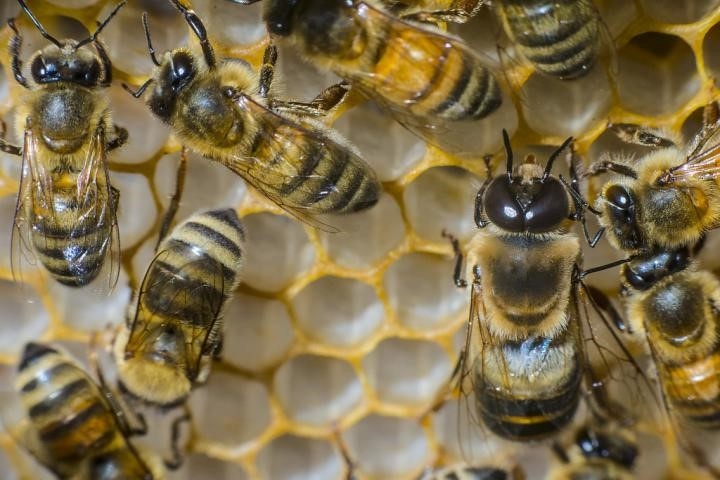ARS researchers working on weapon against nosema parasite in honeybees.

Beekeepers across the U.S. lost 40.7% of their honeybee colonies from April 2018 to April 2019, according to preliminary results of the latest annual nationwide survey conducted by the University of Maryland-led nonprofit Bee Informed Partnership.
According to the announcement, the survey results indicate winter losses of 37.7%, which is the highest winter loss reported since the survey began 13 years ago and 8.9 percentage points higher than the survey average.
Honeybees pollinate $15 billion worth of food crops in the U.S. each year, so their health is critical to food production and supply, the announcement said.
"These results are very concerning, as high winter losses hit an industry already suffering from a decade of high winter losses," said Dennis vanEngelsdorp, associate professor of entomology at the University of Maryland and president for the Bee Informed Partnership.
During the 2018 summer season, beekeepers lost 20.5% of their colonies, which is slightly above the previous year's summer loss rate of 17.1% but about equal to the average loss rate since the summer of 2011, the announcement said. Overall, the annual loss of 40.7% this last year represents a slight increase over the annual average of 38.7%.
"Just looking at the overall picture and the 10-year trends, it's disconcerting that we're still seeing elevated losses after over a decade of survey and quite intense work to try to understand and reduce colony loss," added Geoffrey Williams, assistant professor of entomology at Auburn University and co-author of the survey. "We don't seem to be making particularly great progress to reduce overall losses."
Since beekeepers began noticing dramatic losses in their colonies, state and federal agricultural agencies, university researchers and the beekeeping industry have been working together to understand the cause and develop best management practices to reduce losses.
The annual colony loss survey, which has been conducted since 2006, has been an integral part of that effort. The survey asks commercial and backyard beekeeping operations to track the survival rates of their honeybee colonies. Nearly 4,700 beekeepers managing 319,787 colonies from all 50 states and Washington, D.C., responded to this year's survey, representing about 12% of the nation's estimated 2.69 million managed colonies.
The Bee Informed Partnership team said multiple factors are likely responsible for persistently high annual loss rates and this year's jump in winter losses.
The number-one concern among beekeepers and a leading contributor to winter colony losses is varroa mites, lethal parasites that can readily spread from colony to colony. These mites have been decimating colonies for years, with institutions like the University of Maryland actively researching ways to combat them, the announcement said.
"We are increasingly concerned about varroa mites and the viruses they spread," vanEngelsdorp said. "Last year, many beekeepers reported poor treatment efficacy, and limited field tests showed that products that once removed 90% of mites or more are now removing far fewer. Since these products are no longer working as well, the mite problem seems to be getting worse."
"Mites are not the only problem," vanEngelsdorp added. "Land use changes have led to a lack of nutrition-rich pollen sources for bees, causing poor nutrition. Pesticide exposures, environmental factors and beekeeping practices all play some role as well."
The survey is conducted by the Bee Informed Partnership with data collected and analyzed by the University of Maryland and Auburn University.
Genetic disruption
Researchers with the U.S. Department of Agriculture's Agricultural Research Service (ARS) have taken a first step toward developing a weapon against the major honeybee parasite Nosema ceranae, for which there is currently no treatment.
The scientists found that feeding honeybees a small amount of an interfering RNA compound (RNAi) could disrupt the reproduction of N. cerana by as much as 90% in the laboratory study, according to a study recently published in Insect Molecular Biology.
This RNAi compound targets a single N. ceranae gene called Dicer, explained Jay Evans, research leader of the ARS Bee Research Laboratory in Beltsville, Md., who headed the study.
“Dicer is a critical part of Nosema ceranae’s machinery for defeating honeybees’ immune responses to infestation by these parasites. It also encodes an essential protein in N. ceranae’s reproduction. So, it could be a double-barreled, practical route for attacking N. ceranae. Even better, RNAi against Dicer is specific to the parasite and will not interfere with the health of the honeybees,” Evans said.
In earlier studies, the lab had looked at attacking N. ceranea genes that encode for proteins that make N. ceranae a better parasite, such as a polar tube protein that is important in the parasite's invasion of bee cells, ARS said.
“By striking at a single gene that affects N. ceranae reproduction and the ability of this parasite to counter honeybee immunity, I think we may have found an even better, an excellent, avenue of attack,” Evans added.
According to the announcement, this is just the first step toward a possible treatment. The researchers need to prove the concept in the field and beekeepers’ apiaries.
N. ceranae is widespread problem of honeybees, although the impacts on colony health remain unclear. The best measure of the damage of nosema comes from Europe, where this parasite has been linked to long-term colony declines in Spain, ARS explained.
A chemical treatment had been available, but it was taken off the market due to production challenges, ARS noted.
About the Author(s)
You May Also Like


.png?width=300&auto=webp&quality=80&disable=upscale)
